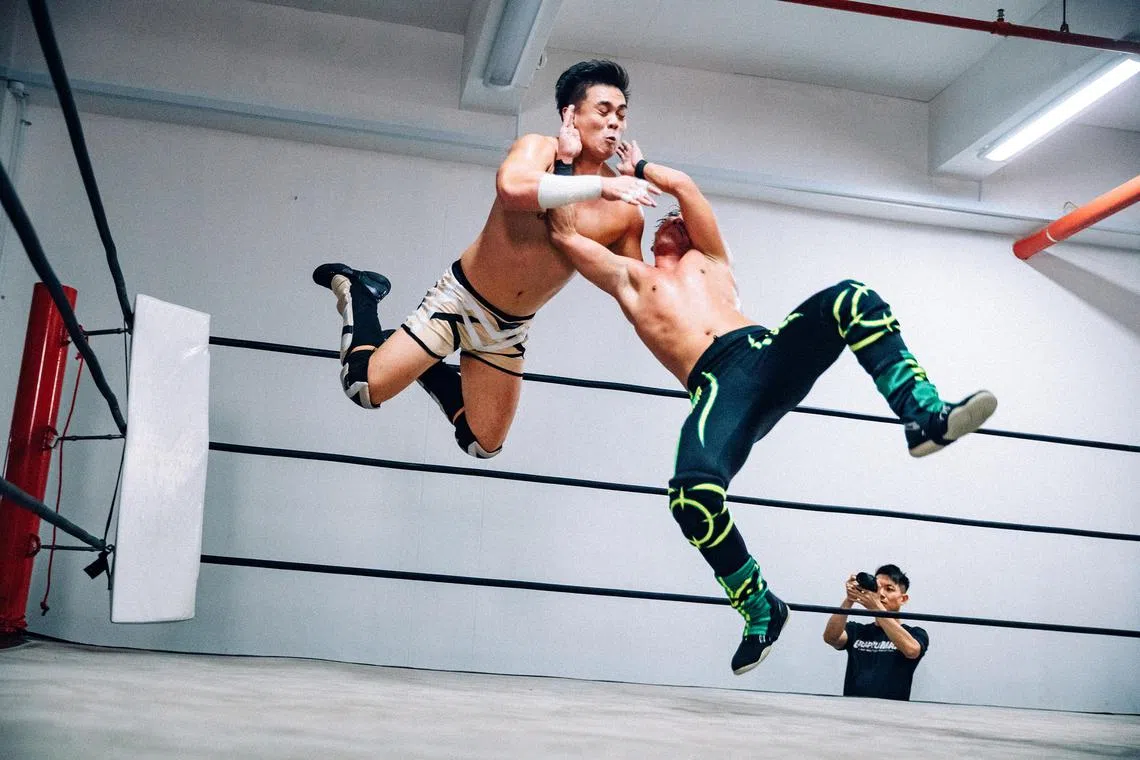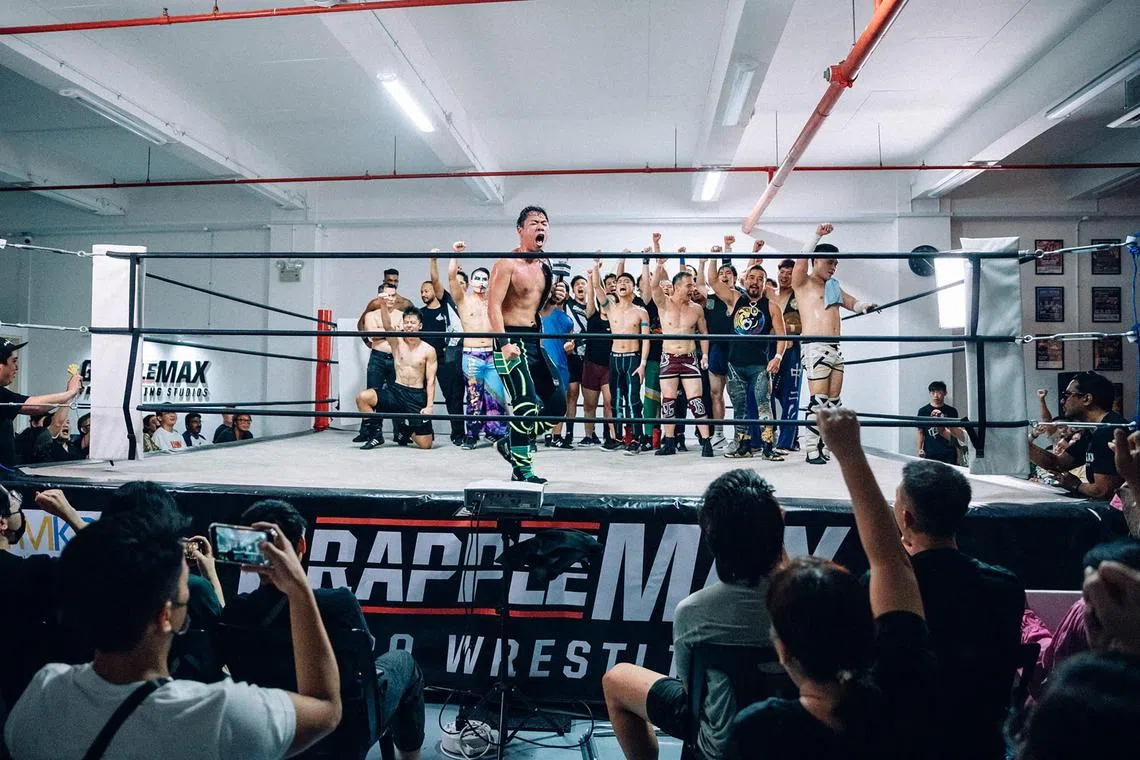Singapore’s pro wrestlers punch above their weight, more than a decade on
Sign up now: Get ST's newsletters delivered to your inbox

Wilson Loh (right) wrestles his opponent Big Dave for the Grapplemax openweight championship belt on Nov 11.
PHOTO: GRAPPLEMAX PRO WRESTLING SINGAPORE
Follow topic:
SINGAPORE – As his opponent leapt at him, Hotshot – real name Wilson Loh – had only a split second to react.
Dodging Big Dave’s lunge and wrapping his arms around his neck, Hotshot used the momentum to drive the Grapplemax openweight champion into the ground, before swiftly pinning him for a three-count.
The jubilant crowd counted along with the referee: “One. Two. Three!”
They erupted in applause and cheers, chanting Hotshot’s name as he lifted the belt as the newly crowned champion.
This is not a segment from a World Wrestling Entertainment (WWE) event, but one from Singapore’s very own professional wrestling scene, which is 11 years old and going strong.
Through the years, local wrestlers – most of whom have day jobs – have honed their craft and now travel the world regularly to perform in countries such as the United States, India, Japan and Malaysia.

Wilson Loh, also known as Hotshot, with the Grapplemax openweight championship belt on Nov 11.
PHOTO: GRAPPLEMAX PRO WRESTLING SINGAPORE/FACEBOOK
Meanwhile, internationally renowned names such as Japanese wrestling legends Tajiri and Dick Togo, All Elite Wrestling (AEW) stars Kenny Omega and Riho, and WWE’s Pete Dunne and Johnny Gargano have flown in to lock horns with local talent.
On Nov 24, WWE alumnus Kalisto – who now goes by Samuray Del Sol – will be added to that list when he performs at a show to mark the 11th anniversary of local promotion Singapore Pro Wrestling (SPW).
In another feather in the cap for the local scene, Grapplemax Pro Wrestling in October signed a partnership with New Japan Pro Wrestling (NJPW) – the third-biggest promotion in the world behind WWE and AEW – which aims to help the Singapore organisation develop more quality home-grown wrestlers.
Professional wrestling, also known as pro wrestling, is best described as a spectacle where participants execute a choreographed series of moves in matches with pre-determined finishes.
Not to be confused with Olympic-style or Greco-Roman wrestling, the realm of pro wrestling allows for performers to tell stories through flashy feats of physical strength and agility under the persona of larger-than-life characters.
SPW, founded in 2012, was the first wrestling promotion in South-east Asia. In the world of pro wrestling, promotions are companies that regularly hold such shows.
The brainchild of Russian national Vadim Koryagin and Singaporean Andruew Tang, SPW now boasts a roster of about 20 active wrestlers and attracts some 700 spectators to each of its public ticketed live shows, which are held between five and seven times a year.
Its brightest star, Sean Tan, now performs as Dante Chen scouted
“SPW sparked a surge of growth and interest in pro wrestling in the country and South-east Asia,” said Tang, whose wrestling persona is The Statement – a brash, confident fighter who is always the centre of attention.
Pro Wrestling Illustrated, the longest-published English-language wrestling magazine still in production, named Tang and fellow SPW wrestler Aiden Rex in its annual list of top 500 male wrestlers in the world. The magazine also ranked Alexis Lee, Singapore’s first female pro wrestler, 148 out of its top 250 female wrestlers worldwide.
To date, Tang, 34, has wrestled and trained in more than 10 territories. Most recently, the full-time pro wrestler returned in June from a three-month tour across Japan, where he battled his way through various events and promotions.
On Nov 24, Tang will share the ring with Samuray Del Sol, the high-flying masked luchador (Mexican pro wrestler) who performed with the WWE from 2013 to 2021, at the Foo Chow Building in Jalan Besar.
“We create an atmosphere with lights, smoke machines and audio at shows. There’s a close intimacy between the crowd and the wrestlers, and for those two to three hours, we bring the fans into our world,” Tang told The Straits Times.
In July, SPW signed a deal with Premier Streaming Network, where its shows will be featured on the entertainment brand’s platform alongside other international brands such as Impact! Wrestling, Major League Wrestling and CZW.
Grapplemax, meanwhile, was founded in 2016 by veteran local wrestlers Dennis Hui and Gregory Ho.
From about five trainees a week then, Grapplemax now has 35 performers and trainees and has staged 49 shows. The latest saw Hotshot winning the title at the organisation’s seventh birthday bash on Nov 11.
Ho, 41, said that the pro wrestling industry in South-east Asia is undergoing a boom with the development of multiple promotions in the region.
“Over the last 10 years, each country’s scene has evolved in its own diverse way, in response to its specific conditions,” he said. “It might be worth noting that Singapore has become a strong case study for fostering a healthy industry dynamic.”
Instead of being rivals, Ho pointed to how Grapplemax and SPW have both thrived.
“This success stems from both companies adopting distinct value propositions and maintaining a mutual respect for each other’s efforts.”
In October, Japanese entertainment company Bushiroad announced the formation of the Asia Pacific Pro Wrestling Alliance, which connects NJPW and its sister promotion Stardom with Grapplemax and other promotions such as Puzzle from Taiwan, DFW from China and Setup from Thailand. The partnership aims to develop stars and a pro-wrestling culture in these territories, according to pro wrestling site Monthly Puroresu.
Aside from delivering shows for fans, SPW and Grapplemax also offer them the chance to live out their wrestling dreams.
From physical conditioning and learning about the psychology – telling a story – in matches, to trash-talking on the mic and developing one’s character, each promotion offers a unique training plan for trainees.
For such trainees to wrestle in front of a live audience, including friends and family in an exhibition match, they have to first undergo a training programme before they are cleared by the promotion to do so. Some may take three to six months, while others may take more, depending on their ability to wrestle convincingly and safely.
Wrestling fans in Singapore told ST that it is the local flavour of SPW and Grapplemax that sets them apart from international promotions, and delivers a fresh take on a performance art that is at least a century old.
Among the colourful characters in the local scene are Aerial Sniper Nyc, who sharpened his skills in the jungles of Pulau Tekong, a training base for the Singapore Army. Today, Nyc wrestles for another smaller local promotion, Ring of Rebirth, which was founded in early 2022 by another veteran local wrestler Kenneth Thexeira, whose “ring name” is The Eurasian Dragon.
Grapplemax’s Hui is known as “Crypto Bro” LK, having reinvented his character from the suave, smooth-talking “shark of Shenton Way”, The Ladykiller.
The tag team of The Horrors – comprising Dr Gore, a doctor from Old Changi Hospital, and his cleaver-wielding, bloodstained apron-donning partner Da Butcherman – continues to be a hit with audiences, while bodybuilder Danie Dharma, who has won multiple awards for his eye-popping physique, has been crushing opponents since 2016 as Destroyer Dharma.
In addition to these unique personas, local pro wrestling fans said they enjoy the community spirit of the shows.
Business development manager Tim Wong, 29, who has attended local pro wrestling shows since the early 2000s, said: “From the ‘two-count’ club that always sits in the front row, to the interactions the referees have with the fans, every show is worth attending.”
“Insults and cheers fly in three or four different languages at every event,” added content editor Darren Chua, 35. “I love it. Of course, some wrestlers give back as good as they get, which is always entertaining to see.”
Ms Umarani Jayapal, a 36-year-old librarian who has been a pro wrestling fan since she was a child, said the local product is just as vibrant and engaging as the ones delivered by the likes of WWE and AEW on TV.
“Local promotions have given us an avenue to express ourselves and being at a wrestling show is so freeing. It’s like going to watch an action movie, but you can actually cheer the heroes and boo the villains out loud,” she said.


